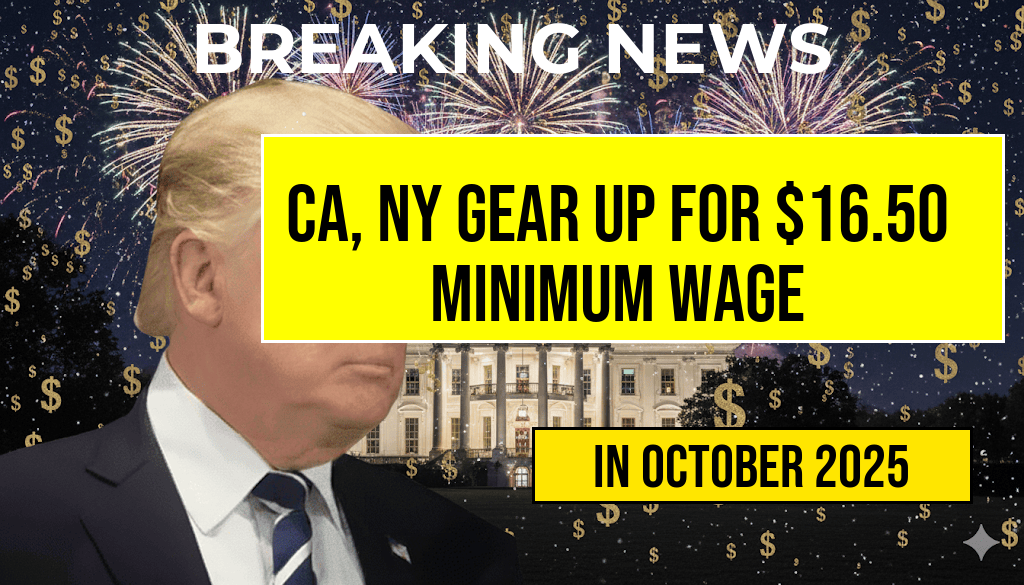California and New York are both preparing to implement significant increases to their minimum wage standards, aiming to reach a uniform rate of $16.50 per hour. The move comes amid ongoing discussions about economic fairness and living costs in these states, which are among the most populous and economically influential in the United States. These planned adjustments are set to impact millions of workers across diverse sectors, from hospitality and retail to healthcare and public services. While the exact timelines vary—California’s phased increases are scheduled to culminate by 2024, and New York’s by 2025—the overarching goal is to elevate wages in response to rising inflation and persistent cost-of-living pressures. This shift signals a broader trend toward higher minimum wages nationwide, prompting both praise for improved worker earnings and concerns about potential repercussions for employers and regional economies.
California’s Path Toward $16.50
California’s minimum wage trajectory has been steadily climbing over the past decade. The state currently enforces a statewide minimum wage of $15.50 per hour for large employers, with smaller businesses subject to a lower rate initially. By 2024, the state intends to reach the $16.50 per hour benchmark, aligning with the broader goal of narrowing income disparities and supporting the economic stability of low-wage workers.
The increase is part of California’s broader efforts to address affordability issues, especially in high-cost urban centers like Los Angeles, San Francisco, and San Diego. State officials argue that raising the minimum wage is critical in helping workers keep pace with inflation and housing costs, which have soared in recent years.
Implementation is phased in, with scheduled adjustments that allow businesses time to adapt. The California Department of Industrial Relations (DIR) has outlined a timeline that sees incremental increases each year, culminating in the $16.50 target by January 2024. This phased approach aims to balance economic growth with wage improvements, although critics warn it could increase operational costs for small businesses.
New York’s Incremental Approach to $16.50
New York State’s plan mirrors California’s in its phased implementation, but with its unique regional considerations. The state currently enforces a minimum wage of $15 per hour in New York City, with lower rates in upstate regions. The state’s goal is to reach $16.50 per hour across all regions by 2025, a move that aligns with the state’s broader commitment to economic equity.
Governor Kathy Hochul announced that the increases will be phased in over the next two years, with the final rate likely to take effect at the start of 2025. The plan considers regional economic differences, with urban centers expected to see higher wages sooner, while rural areas may experience a slower transition.
Supporters contend that the wage hike will bolster consumer spending and reduce poverty levels, but opponents raise concerns about potential job losses or increased automation, especially among small employers facing tighter margins.
Economic and Political Implications
Impact on Employers and Workers
- Small businesses may face increased labor costs, potentially leading to higher prices or reduced staffing levels.
- Workers are expected to benefit from higher earnings, which could improve living standards and reduce reliance on social safety nets.
- Some industries, such as hospitality, retail, and food service, are particularly sensitive to wage hikes, prompting ongoing debates about competitiveness.
State-Level Policy Dynamics
Both California and New York have historically positioned themselves as leaders in progressive labor policies. Their push toward a $16.50 minimum wage reflects a broader trend among states seeking to address economic inequality. However, these initiatives also face opposition from business groups and conservative policymakers concerned about economic growth and employment levels.
The federal minimum wage remains at $7.25 per hour, but with growing regional disparities, states like California and New York are carving out their own paths. According to the Wikipedia page on minimum wages in the U.S., many states are gradually increasing their mandated wages to better reflect local economic conditions.
Projected Effects and Public Sentiment
| Aspect | Expected Outcome |
|---|---|
| Worker Earnings | Significant increase in income for low-wage workers, improving quality of life. |
| Business Costs | Potential rise in operational expenses, especially for small and mid-sized firms. |
| Employment Levels | Mixed predictions; some studies suggest minimal impact, others warn of possible job reductions in certain sectors. |
| Consumer Spending | Likely to increase due to higher disposable income among low-wage earners. |
| Inflation | Possible upward pressure if increased wages lead to higher prices. |
Public opinion remains divided. Advocates highlight the importance of living wages and economic justice, citing research from organizations like the Economic Policy Institute that links higher wages to reduced poverty. Conversely, critics warn that rapid increases may dampen job growth or strain small business viability, especially during periods of economic uncertainty.
Frequently Asked Questions
What is the upcoming minimum wage increase in California and New York?
The minimum wage in both California and New York is set to increase to $16.50 per hour.
When will the new minimum wage take effect?
The increase to $16.50 per hour is scheduled to take effect on January 1, 2024.
Which workers will be affected by the wage increase?
The minimum wage increase will impact most hourly workers across various industries in California and New York.
Are there any exceptions or phased-in implementations for the wage hike?
Yes, some small businesses or localities might have phased-in plans or specific exemptions, but generally, the $16.50 per hour rate applies broadly.
What are the reasons behind the minimum wage increase?
The wage hike aims to improve living standards, reduce income inequality, and align wages with the cost of living increases in California and New York.






